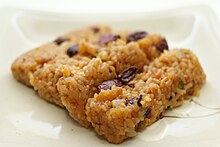
Korean cuisine has evolved through centuries of social and political change. Originating from ancient agricultural and nomadic traditions in Korea and southern Manchuria,Korean cuisine reflects a complex interaction of the natural environment and different cultural trends.

Gochujang or red chili paste is a savory,sweet,and spicy fermented condiment popular in Korean cooking. It is made from gochu-garu,glutinous rice,meju powder,yeotgireum,and salt. The sweetness comes from the starch of cooked glutinous rice,cultured with saccharifying enzymes during the fermentation process. Traditionally,it would be naturally fermented over years in jangdok (earthenware) on an elevated stone platform called jangdokdae in the backyard.

Korean royal court cuisine was the style of cookery within Korean cuisine traditionally consumed at the court of the Joseon Dynasty,which ruled Korea from 1392 to 1910. There has been a revival of this cookery style in the 21st century. It is said that twelve dishes should be served along with rice and soup,with most dishes served in bangjja (bronzeware).

Daeboreum is a Korean holiday that celebrates the first full moon of the new year of the lunar Korean calendar which is mostly based on the lunisolar Chinese calendar. The festival is Korean version of the First Full Moon Festival. This holiday is accompanied by many traditions.
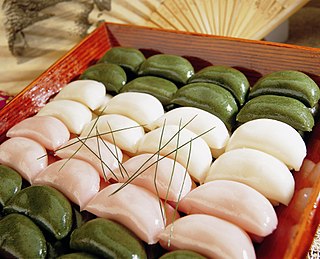
Songpyeon is a traditional Korean food made of rice powder. Its shape resembles a half moon and it is a representative rice cake of Korean holidays and traditional culture. It is a type of tteok,small rice cakes,and variety of fillings are used—some include red bean paste,toasted sesame seeds,and chestnuts. Songpyeon is traditionally eaten during the Korean autumn harvest festival,Chuseok,where it is often prepared by families at home. It is a popular symbol of traditional Korean culture. The earliest records of songpyeon date from the Goryeo period.

Tteok is a general term for Korean rice cakes. They are made with steamed flour of various grains,especially glutinous and non-glutinous rice. Steamed flour can also be pounded,shaped,or pan-fried to make tteok. In some cases,tteok is pounded from cooked grains.

Korean noodles are noodles or noodle dishes in Korean cuisine,and are collectively referred to as "guksu" in native Korean or "myeon" in hanja character. Preparations with noodles are relatively simple and dates back to around 6000 BCE to 5000 BCE in Asia. In Korea,traditional noodle dishes are onmyeon,called guksu jangguk,naengmyeon,bibim guksu,kalguksu,kongguksu among others. In royal court,baekmyeon consisting of buckwheat noodles and pheasant broth,was regarded as the top quality noodle dish. Naengmyeon,with a cold soup mixed with dongchimi and beef brisk broth,was eaten in court during summer.
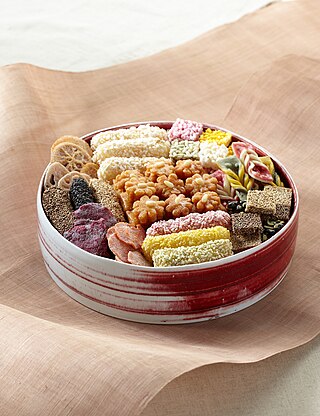
Hangwa is a general term for traditional Korean confections. With tteok,hangwa forms the sweet food category in Korean cuisine. Common ingredients of hangwa include grain flour,fruits and roots,sweet ingredients such as honey and yeot,and spices such as cinnamon and ginger.

Yumil-gwa is a variety of hangwa,a traditional Korean confection. Different varieties of yumil-gwa can be made by combining a wheat flour dough with various ingredients such as:honey,cooking oil,cinnamon powder,nuts,ginger juice,jujube,and cheongju.

Suksil-gwa,literally "cooked fruit",is a category of hangwa consisting of cooked fruit,roots,or seeds sweetened with honey. Common ingredients include chestnut,jujube,and ginger. Suksil-gwa is similar to—and sometimes classified as—jeonggwa,but has unique characteristics that differentiate it from the jeonggwa category.

Baeksuk is a Korean culinary term referring to dishes made by boiling or steaming meat or fish to be cooked thoroughly without seasonings. Baeksuk is made with chicken or pheasant with plenty of water for several hours. However,the term generally indicates dakbaeksuk,or chicken stew,whose recipe and ingredients are similar to samgyetang. While samgyetang is made with ginseng,various herbs,chestnuts,and jujubes,dakbaeksuk consists of simpler ingredients,such as chicken,water,and garlic. The chicken can be stuffed with glutinous rice.
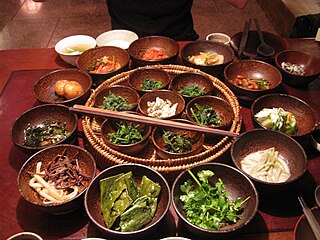
Korean temple cuisine refers to a type of cuisine that originated in Buddhist temples of Korea. Since Buddhism was introduced into Korea,Buddhist traditions have strongly influenced Korean cuisine as well. During the Silla period,chalbapyakgwa and yumilgwa were served for Buddhist altars and have been developed into types of hangwa,Korean traditional confectionery. During the Goryeo Dynasty,sangchu ssam,yaksik,and yakgwa were developed,so spread to China and other countries. Since the Joseon Dynasty,Buddhist cuisine has been established in Korea according to regions and temples.
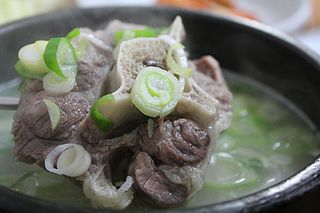
Gomguk (Korean: 곰국),gomtang (곰탕),or beef bone soup refers to a soup in Korean cuisine made with various beef parts such as ribs,oxtail,brisket,ox's head or ox bones by slow simmering on a low flame. The broth tends to have a milky color with a rich and hearty taste.
Korean regional cuisines are characterized by local specialties and distinctive styles within Korean cuisine. The divisions reflected historical boundaries of the provinces where these food and culinary traditions were preserved until modern times.
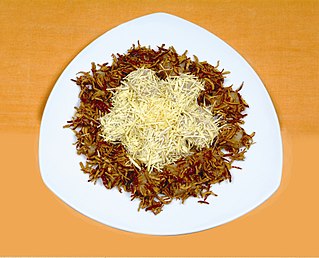
Danja is a variety of steamed tteok made with glutinous rice flour,sweet fillings,and sweet coatings.

Bap is a Korean name for cooked rice prepared by boiling rice or other grains,such as black rice,barley,sorghum,various millets,and beans,until the water has cooked away. Special ingredients such as vegetables,seafood,and meat can also be added to create different kinds of bap. In the past,except for the socially wealthy class,people used to eat mixed grain rice together with beans and barley rather than only rice.
